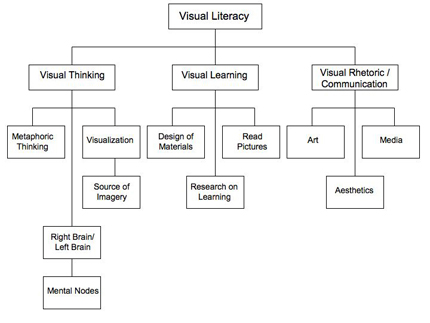Visual Rhetoric: Overview

Welcome to the Purdue OWL
This page is brought to you by the OWL at Purdue University. When printing this page, you must include the entire legal notice.
Copyright ©1995-2018 by The Writing Lab & The OWL at Purdue and Purdue University. All rights reserved. This material may not be published, reproduced, broadcast, rewritten, or redistributed without permission. Use of this site constitutes acceptance of our terms and conditions of fair use.
This section of the OWL discusses the use of rhetorical theory and rhetoric as it relates to visuals and design. "Visual rhetoric" has been used to mean anything from the use of images as argument, to the arrangement of elements on a page for rhetorical effect, to the use of typography (fonts), and more.
While we cannot hope to cover these and many other topics in depth in this resource, it will be possible for us to look at some of the common visual rhetoric problems encountered by student writers: the text elements of a page (including font choices), the use of visuals (including photographs, illustrations, and charts and graphs), and the role of overall design in composing a page rhetorically.
Note: Much of the current use of "visual rhetoric" is directed at analyzing images and other visuals that already exist. This handout is meant to help you generate visual material.
What is visual rhetoric?
The term visual rhetoric falls under an umbrella term known as visual literacy, which is generally split into three categories: visual thinking, visual learning, visual rhetoric/communication (though clearly visual thinking and visual learning must occur in order to communicate visually). The following diagram illustrates these ideas. The graphic is modified from Sandra Moriarty's diagram in her essay, "A Conceptual Map of Visual Communication" and from "Teaching Visual Literacy and Document Design in First-Year Composition" (MA Thesis) by Allen Brizee.

Visual Literacy
Essentially, a beginning definition of visual rhetoric and its applications are as follows:
- Use of images as argument
- Arrangement of elements on a page
- Use of typography (fonts, etc.)
- Analysis of existing images and visuals
Other OWL resources that are related to visual rhetoric and that may help you understand these ideas are the following:
- Visual Rhetoric Slide Presentation
- Color Theory Slide Presentation
- Using Fonts with Purpose
- Design an Effective PowerPoint Presentation
- HATS (Headings, Access, Typography, and Space) Slide Presentation: A Design Procedure for Routine Business Documents
For more information:
You may also download the pdf Works Cited and Works Referenced from "Teaching Visual Literacy and Document Design in First-Year Composition" in the Media box above. This pdf contains a number of resources on visual literacy, visual rhetoric, and document design and the uses of these concepts in composition and professional writing.